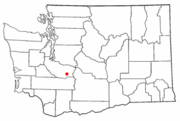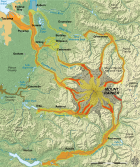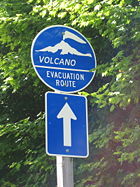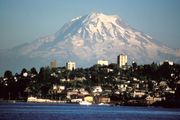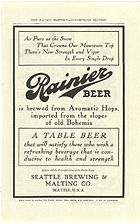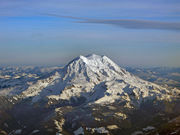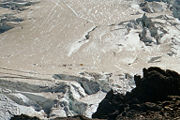Mount Rainier
2008/9 Schools Wikipedia Selection. Related subjects: North American Geography
| Mount Rainier | |
|---|---|
 Mount Rainier as viewed from the northeast. |
|
| Elevation | 14,411 ft (4,392 m) |
| Location | Washington State, USA |
| Range | Cascade Range |
| Prominence | 13,210 ft (4,026 m) Ranked 21st |
| Coordinates | |
| Topo map | USGS Mount Rainier West |
| Type | Stratovolcano |
| Volcanic arc/ belt | Cascade Volcanic Arc |
| Age of rock | 500,000 years |
| Last eruption | 1854 |
| First ascent | 1870 by Hazard Stevens and P. B. Van Trump |
| Easiest route | rock/ice climb via Disappointment Cleaver |
Mount Rainier is an active stratovolcano (also known as a composite volcano) in Pierce County, Washington, located 54 miles (87 km) southeast of Seattle, Washington, in the United States. It is the highest peak in the Cascade Range and Cascade Volcanic Arc at 14,411 feet (4,392 m). The mountain and the surrounding area are protected within Mount Rainier National Park. With 26 major glaciers, Mount Rainier is the most heavily glaciated peak in the lower 48 states with 35 square miles (91 km²) of permanent snowfields and glaciers. The summit is topped by two volcanic craters, each over 1,000 feet (300 m) in diameter with the larger east crater overlapping the west crater. Geothermal heat from the volcano keeps areas of both crater rims free of snow and ice, and has formed an extensive network of glacier caves within the ice-filled craters. A small crater lake, the highest in North America, occupies the lowest portion of the west crater below more than 160 feet (50 m) of ice and is accessible only via the caves.
Mount Rainier was originally known as Talol, or Tahoma, from the Lushootseed word təqʷúʔbəʔ ("mother of waters") spoken by the Puyallup. It has a topographic prominence of 13,210 feet (4,026 m), greater than that of K2. It is a prominent feature of the southern landscape in most of the Seattle metropolitan area. On clear days, it can also be seen from as far away as Portland, Oregon, and Victoria, British Columbia. Because of its scenic dominance, Seattle- Tacoma-area residents often refer to it simply as "the Mountain."
The Carbon, Puyallup, Mowich, Nisqually, and Cowlitz Rivers begin at eponymous glaciers of Mount Rainier. The sources of the White River are Winthrop, Emmons, and Fryingpan Glaciers. The White, Carbon, and Mowich join the Puyallup River, which discharges into Commencement Bay at Tacoma; the Nisqually empties into Puget Sound east of Lacey; and the Cowlitz joins the Columbia River between Kelso and Longview.
Geological history
Mount Rainier's earliest lavas are over 840,000 years old and are part of the Lily Formation (2.9 million to 840,000 years ago). The early lavas formed a "proto-Rainier" or an ancestral cone prior to the present-day cone. The present cone is over 500,000 years old. The volcano is highly eroded, with glaciers on its slopes, and appears to be made mostly of andesite. Rainier likely once stood even higher than today at about 16,000 feet (4,900 m) before a major debris avalanche and the resulting Osceola Mudflow 5,000 years ago.
In the past, Rainier has had large debris avalanches, and has also produced enormous lahars (volcanic mudflows) due to the large amount of glacial ice present. Its lahars have reached all the way to the Puget Sound. Around 5,000 years ago, a large chunk of the volcano slid away and that debris avalanche helped to produce the massive Osceola Mudflow, which went all the way to the site of present-day Tacoma and south Seattle. This massive avalanche of rock and ice took out the top 1,600 feet (500 m) of Rainier, bringing its height down to around 14,100 feet (4,300 m). About 530 to 550 years ago, the Electron Mudflow occurred, although this was not as large-scale as the Osceola Mudflow.
After the major collapse 5,000 years ago, subsequent eruptions of lava and tephra built up the modern summit cone until about as recently as 1,000 years ago. As many as 11 Holocene tephra layers have been found.
The most recent recorded volcanic eruption was between 1820 and 1854, but many eyewitnesses reported eruptive activity in 1858, 1870, 1879, 1882 and 1894 as well. As of 2008, there is no imminent risk of eruption, but geologists expect that the volcano will erupt again.
Lahars from Rainier pose the most risk to life and property, as many communities lie atop older lahar deposits. Not only is there much ice atop the volcano, the volcano is also slowly being weakened by hydrothermal activity. According to Geoff Clayton, a geologist with RH2, a repeat of the Osceola mudflow would destroy Enumclaw, Kent, Auburn, and most or all of Renton. Such a mudflow might also reach down the Duwamish estuary and destroy parts of downtown Seattle, and cause tsunamis in Puget Sound and Lake Washington. According to USGS, about 150,000 people live on top of old lahar deposits of Rainier. Rainier is also capable of producing pyroclastic flows as well as lava.
Human history
Mount Rainier was first known by the Native Americans as Talol, Tahoma, or Tacoma, from the Lushootseed word təqʷúʔbəʔ ("mother of waters") spoken by the Puyallup. At the time of European contact, the river valleys and other areas near the mountain were inhabited by many Pacific Northwest tribes who hunted and gathered berries in the forests and mountain meadows. These included the Nisqually, Cowlitz, Yakama, Puyallup, and Muckleshoot.
Captain George Vancouver reached Puget Sound in 1792 and became the first European to see the mountain. He named it in honour of his friend, Rear Admiral Peter Rainier.
In 1833, Dr. William Fraser Tolmie explored the area looking for medicinal plants. He was followed by other explorers seeking challenge. Hazard Stevens and P. B. Van Trump received a hero's welcome in the streets of Olympia after their successful summit climb in 1870. John Muir climbed Mount Rainier in 1888, and although he enjoyed the view, he conceded that it was best appreciated from below. Muir was one of many who advocated protecting the mountain. In 1893, the area was set aside as part of the Pacific Forest Reserve in order to protect its physical/economic resources: timber and watersheds.
Citing the need to also protect scenery and provide for public enjoyment, railroads and local businesses urged the creation of a national park in hopes of increased tourism. On March 2, 1899, President William McKinley established Mount Rainier National Park as America's fifth national park. Congress dedicated the new park "for the benefit and enjoyment of the people; and...for the preservation from injury or spoliation of all timber, mineral deposits, natural curiosities, or wonders within said park, and their retention in their natural condition."
In 1998, the United States Geological Survey began putting together the Mount Rainier Volcano Lahar Warning System to assist in the emergency evacuation of the Puyallup River valley in the event of a catastrophic debris flow. It is now run by the Pierce County Department of Emergency Management. Tacoma, at the mouth of the Puyallup, is only 37 miles (60 km) west of Rainier, and moderately sized towns such as Puyallup and Orting are only 27 miles (43 km) and 20 miles (32 km) away, respectively.
Naming controversy
Although "Rainier" had been considered the official name of the mountain, Theodore Winthrop, in his posthumously published 1862 travel book The Canoe and the Saddle, claimed the indigenous name of the mountain was "Tacoma" and afterwards, both names were used interchangeably, although "Mt. Tacoma" was preferred in the city of Tacoma.
In 1890, the United States Board on Geographic Names declared that the mountain would be known as "Rainier". Following this in 1897, the Pacific Forest Reserve became the Mount Rainier Forest Reserve, and the national park was established three years later. Despite this, there was still a movement to change the mountain's name to "Tacoma" and Congress was still considering a resolution to change the name as late as 1924.
After Rainier Brewing Company resumed producing "Rainier Beer" after the end of Prohibition and its advertisements became ubiquitous in the Seattle-Tacoma area, a rumor began circulating that the brewery's owner, Emil Sick, had bribed a Washington state committee with free beer to promote the name "Rainier". This, however, is an urban legend and can still be heard today among Tacoma residents who preferred the alternate name. Sick did, however, purchase the local baseball team and named them the Seattle Rainiers for this purpose.
Subsidiary peaks
The broad top of Mount Rainier contains three named summits. The highest is called Columbia Crest. The second highest summit is Point Success, 14,158 feet (4,315 m), at the southern edge of the summit plateau, atop the ridge known as Success Cleaver. It has a topographic prominence of about 138 feet (42 m), so it is not considered a separate peak. The lowest of the three summits is Liberty Cap, 14,112 feet (4,301 m), at the northwestern edge, which overlooks Liberty Ridge, the Sunset Amphitheater, and the dramatic Willis Wall. Liberty Cap has a prominence of 492 feet (150 m), and so would qualify as a separate peak under most strictly prominence-based rules. A prominence cutoff of 400 feet (122 m) is commonly used in Washington state. However it is not usually considered a separate peak, due to the massive size of Mount Rainier, relative to which a 492 foot (150 m) drop is not very large.
High on the eastern flank of Mount Rainier is a peak known as Little Tahoma, 11,138 feet (3,395 m), an eroded remnant of the earlier, much higher, Mount Rainier. It has a prominence of 858 feet (262 m), and it is almost never climbed in direct conjunction with Columbia Crest, so it is usually considered a separate peak. If considered separately from Mt. Rainier, Little Tahoma would be the third highest Mountain peak in Washington.
Climbing and recreation
Mountain climbing on Mount Rainier is very difficult; it involves climbing on the largest glaciers in the U.S. south of Alaska. Most climbers require two to three days to reach the summit. Climbing teams require experience in glacier travel, self-rescue, and wilderness travel. About 8,000 to 13,000 people attempt the climb each year, about 90% via routes from Camp Muir on the southeast flank. Most of the rest ascend Emmons Glacier via Camp Schurman on the northeast. About half of the attempts are successful, with weather and conditioning being the most common reasons for failure. About three mountaineering deaths each year occur due to rock and ice fall, avalanche, falls, and hypothermia associated with severe weather.
Hiking, photography, and camping are popular in the park. Hiking trails, including the Wonderland Trail, a 93 mile circumnavigation of the peak provide access to the backcountry. Mount Rainier is also popular for winter sports, including snowshoeing and cross-country skiing. In summer, visitors pass through vast meadows of wildflowers, on trails emanating from historic Paradise Inn.
Washington state quarter
The Washington state quarter, which was released on April 11, 2007, features Mount Rainier and a salmon.
